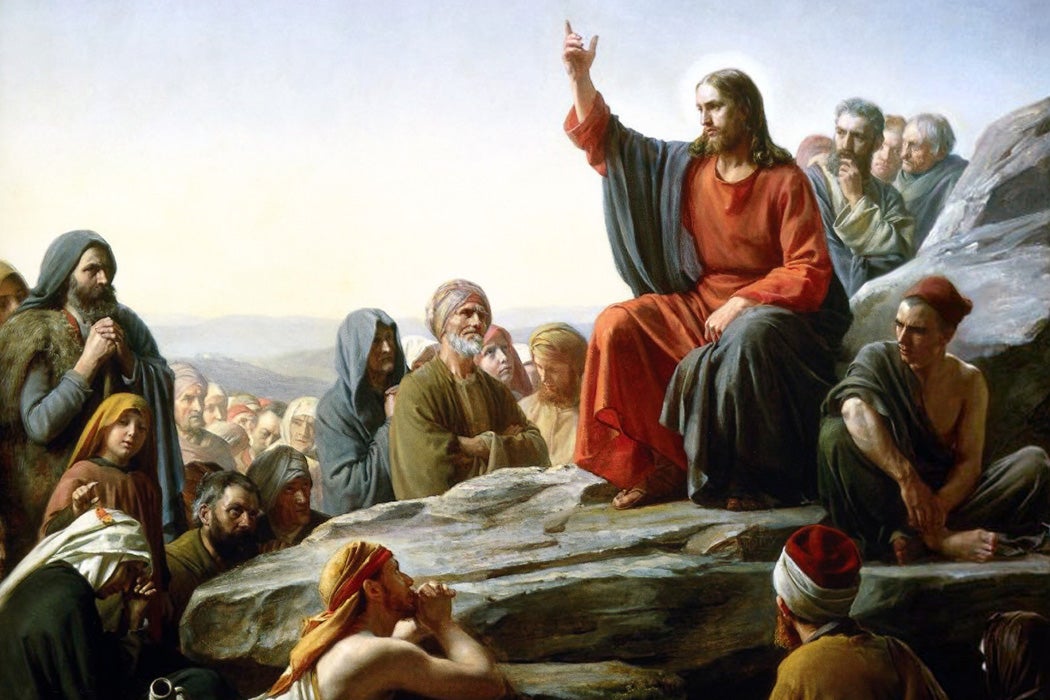There are some Bible verses that have become such a part of secular culture that we receive them as generic platitudes, interpreting them in simplified, anachronistic ways. For example, on the morning of March 21, 2018, the nation’s Capricorns were greeted with a biblical warning when they checked their daily horoscope: “Judge not, lest ye be judged.” That sentence, of course, comes from the Sermon on the Mount in Matthew 5–7. Here’s how the King James Version of the Bible renders Jesus’s timeless maxim: “Judge not, that ye be not judged. For with what judgement ye judge, ye shall be judged.”
The horoscope, penned by syndicated astrologer Jeraldine Saunders, clarified the meaning of the cryptic verse in the next sentence. “It’s not for you to say,” wrote Saunders, “if someone wants to do something that you consider foolish or silly.”
In this digestible, secularized gloss of the verse, Jesus’s imperative suddenly feels like a tolerationist bromide on par with “to each her own” and “live and let live.” Or, as one education scholar in 1964 called it, a “harmless aphorism.”
But is that really all it is? Judging by the array of sources and intellectual byways opened up by the JSTOR Understanding Series for the King James Version of the Bible, the answer to this question is a definitive “No.”
Best to begin at the beginning. Even in the early days of Christian thought, this verse proved tricky. It was one that second-century Christian theologian Tertullian returned to many times throughout his life. According to historian Jaroslav Pelikan’s article on the early church father, Tertullian wrestled with Jesus’s proscription in an eschatological frame. Given the close connection between ethics and eschatology in Jesus’s teachings, Tertullian concluded that the command to “judge not” is a reminder to us that judgement and punishment are not ours to mete, but God’s.
Yet even if judgement ultimately resides with a power greater than ourselves, for centuries Bible readers have struggled with putting that interpretation into practice, given how naturally judgement comes.
Nineteenth-century American Christians were especially torn. Poet John Greenleaf Whittier wrote that the verse had “an awful import” because it so definitively placed judgement not with “blind & weak” people but with “Him to whom judgement belongeth.” And Abraham Lincoln famously used the verse to great effect in his Second Inaugural address when he noted of the South, “it may seem strange that any men should dare to ask a just God’s assistance in wringing their bread from the sweat of other men’s faces; but let us judge not that we be not judged.” Scholars have debated whether Lincoln meant the verse to be a gesture of mercy or a satiric jab. If contemporaneous reports are any indication, the audience that day thought the latter, since this part of the speech elicited from them “a half laugh.”
Church of Jesus Christ of Latter-day Saints prophet Joseph Smith attempted to answer the verse’s difficulties in his translation of the Bible by rendering the saying as, “Judge not unrighteously, that ye be not judged.” Here, the critical interjection of the adverb “unrighteously” changes the character of the verse. No longer are we prevented from judgement in every instance. Instead, Jesus places constraints on how we judge.
Weekly Digest
To an extent, this view is in accordance with that of former president of the American Philosophical Society, Jeffrie G. Murphy, although Murphy adopts a secular approach. In his view, the passage is not, in fact, “a prohibition against making any critical moral judgments at all but is rather a caution against making final judgments of deep character.” In this reading, the verse calls us to self-reflection and introspection, not quietism. We can still pass judgement, but before we do we must exercise extreme restraint, scrutinizing ourselves in such a way as to close the gap between ourselves and the person upon whom we want to pass judgement.
Clearly, Jesus’s maxim is one that lends itself to a variety of interpretations. It has been used to justify a broad-minded toleration towards the actions of others, as a recognition of our own moral limitations, or as a call for deep and sustained self-analysis. A definitive answer eludes us. What is clear is that it demands we pay attention to one of the most consequential activities in our moral life–how we view and assess our fellows–one that is too often exercised like an unconscious reflex.
More canonical texts, from the works of Shakespeare to Rabindranath Tagore’s Gitanjali and many more, can be accessed via the JSTOR Understanding Series!







